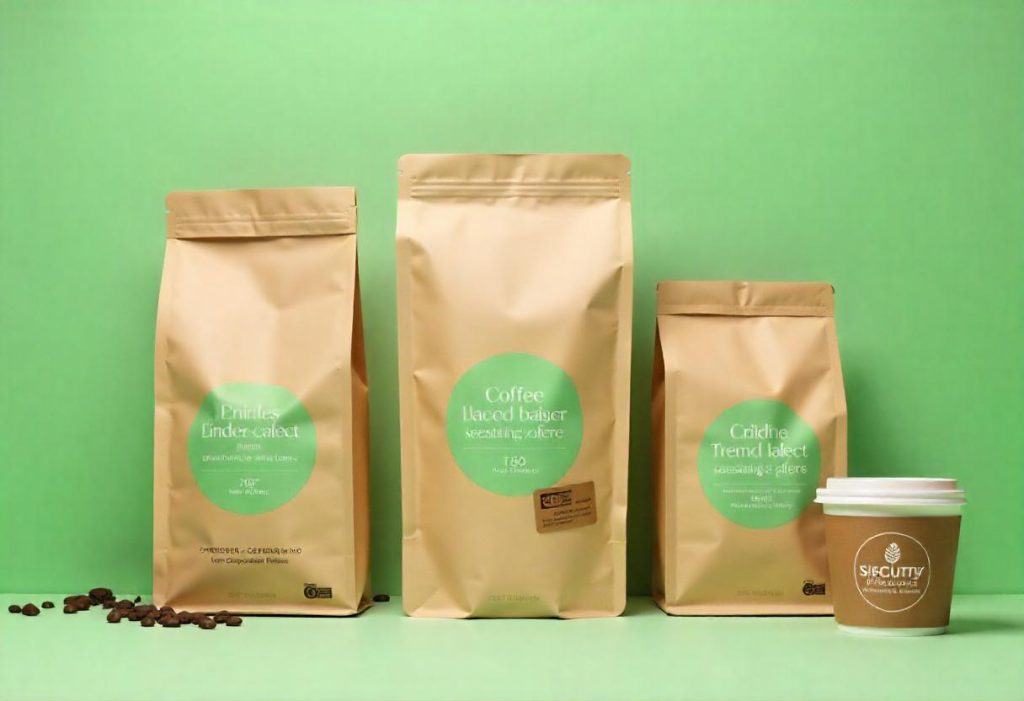How to Balance Cost and Sustainability in Coffee Packaging
The coffee industry is under growing pressure to strike a balance between cost and sustainability in packaging. As consumers increasingly demand eco-friendly practices and brands seek ways to reduce packaging expenses, finding affordable, environmentally responsible solutions has become more important than ever. With sustainability becoming a key factor in consumer purchasing decisions, coffee companies are facing the challenge of meeting these expectations without significantly inflating their costs. This article explores practical strategies for balancing affordability with eco-consciousness in coffee packaging, while also highlighting sustainable materials and innovative solutions that not only minimize environmental impact but also align with the industry’s drive for cost-efficiency. By adopting these approaches, coffee brands can maintain profitability while contributing to a more sustainable future.
1. Understanding the Challenges of Eco-Friendly Coffee Packaging
Eco-friendly coffee packaging solutions are essential in today’s coffee industry, but achieving a balance between cost and sustainability is challenging. The transition to sustainable materials for coffee packaging requires investment, and costs can vary significantly depending on the material and production process.
Benefits of Sustainable Packaging:
- Consumer Appeal: 75% of consumers prefer brands that adopt green practices in the coffee industry.
- Waste Reduction: Eco-packaging helps reduce coffee packaging waste, supporting environmental conservation.
- Brand Value: Companies that prioritize eco-friendly practices gain a competitive edge, attracting environmentally conscious customers.
| Material Type | Average Cost per Unit | Key Benefit |
| Compostable coffee packaging | $0.15 – $0.30 | Reduces waste in landfills |
| Recyclable coffee packaging | $0.10 – $0.25 | Allows for multiple uses |
| Biodegradable coffee bags | $0.20 – $0.35 | Decomposes naturally over time |
Switching to eco-friendly options does incur upfront costs, but brands that commit to sustainable practices find a valuable long-term investment.
2. Sustainable Materials for Coffee Packaging: Choosing the Right Option
Choosing sustainable materials for coffee packaging depends on factors like product shelf-life, budget, and environmental impact. Compostable coffee packaging options are highly sought-after, yet low-cost sustainable coffee packaging materials like recycled paper and plant-based plastics are increasingly used due to their affordability and functionality.
Types of Eco-Friendly Packaging Materials:
- Biodegradable Coffee Bags: Made from materials like plant starch and cellulose, biodegradable coffee bags decompose in natural settings.
- Recycled Paper and Cardboard: Cost-effective and easy to source, these materials are ideal for coffee packaging due to their renewability and versatility.
- Compostable Coffee Packaging Options: Such packaging is designed to decompose in composting conditions, making it a top choice for eco-conscious brands.
| Material | Sustainability Level | Cost Efficiency | Use Case Example |
| Plant-Based Plastic | High | Medium | Single-use coffee pouches |
| Recycled Paper | Medium | High | Box packaging, outer cartons |
| PLA (Polylactic Acid) | High | Medium | Biodegradable coffee pod packaging |
| Hemp-Based Packaging | High | Medium | Bags and wrappers for coffee beans |
With the variety of renewable resources for coffee packaging, companies can select solutions that match their budget while minimizing environmental impact.
3. Benefits of Cost-Effective, Sustainable Coffee Packaging
Balancing cost and sustainability offers significant benefits to coffee brands and their customers. Environmentally conscious coffee packaging contributes to a positive brand image and meets customer demand for eco-friendly options. Additionally, companies that invest in sustainable materials reduce waste, improve operational efficiency, and minimize their carbon footprint.
Advantages of Sustainable Coffee Packaging:
- Environmental Impact: Low-cost sustainable coffee packaging materials, such as recycled paper and PLA, help reduce waste and conserve resources.
- Brand Loyalty: Customers are more likely to support brands with affordable eco-packaging for coffee, especially as awareness around environmental issues grows.
- Cost Savings Over Time: Although the initial costs might be higher, many brands find that green packaging practices in the coffee industry offer savings in the long run.
This balance between cost-effectiveness and environmental consciousness is crucial for coffee brands aiming to maintain profitability and sustainability.

4. Tips to Balance Cost and Sustainability in Coffee Packaging
Cost vs. sustainability in coffee packaging design can be tricky, but a strategic approach can help manage costs while incorporating green practices. Here are some practical tips:
- Bulk Purchasing of Sustainable Materials: Buying in bulk reduces per-unit costs, making it easier to invest in recyclable coffee packaging alternatives without inflating the budget.
- Eco-Friendly Ink for Printing: Use soy-based inks that are both cost-effective and eco-friendly for branding on packaging.
- Select Compostable Packaging for Certain Products: Identify products that can benefit from compostable options without adding unnecessary costs. For example, high-end coffee lines can use compostable bags to attract premium customers.
- Emphasize Minimalist Design: Using less material by simplifying packaging design reduces costs and supports environmentally conscious coffee packaging.
- Partner with Sustainable Suppliers: Sourcing materials from suppliers with eco-friendly practices can lower the overall environmental impact and often result in competitive pricing.
Using these tips, coffee brands can find an effective middle ground, ensuring they meet environmental goals while staying within budget constraints.
5. Pioneering Sustainable Coffee Packaging for the Future
With rising demand for affordable eco-packaging for coffee, the industry must focus on sustainable practices. Brands committed to using recyclable, compostable, or biodegradable materials are at the forefront of innovation. Renewable resources for coffee packaging not only address environmental concerns but also enhance a brand’s market position.
Key Takeaways:
- Invest in Biodegradable Coffee Bags: Despite slightly higher costs, they are essential for brands aiming to reduce their environmental footprint.
- Educate Consumers on Recyclable Coffee Packaging Alternatives: Encourage customers to participate in recycling programs, which helps amplify the impact of sustainable packaging.
- Continually Assess Material Costs: As green packaging practices evolve, new affordable materials and designs emerge, offering more options for eco-conscious brands.
Balancing cost and sustainability in coffee packaging is possible with a mindful approach and a commitment to environmental stewardship. The future of coffee packaging is both green and economically viable, driven by innovation and customer expectations.
Innovative Packaging Solutions for a Greener Future
As the demand for sustainable packaging grows, the coffee industry is embracing innovative solutions that extend beyond traditional recyclable and compostable materials. Key advancements include:
- Plant-Based Plastics: These materials are derived from renewable resources, reducing reliance on petroleum-based plastics and minimizing environmental impact.
- Biodegradable Materials: Packaging made from biodegradable substances helps reduce waste that can persist in landfills.
- Edible Packaging: Some companies are exploring edible packaging options, offering an exciting, waste-free alternative.
- New Recycling Methods: Emerging recycling technologies are making it easier to recycle coffee packaging, helping brands reduce waste and improve sustainability.
- Zero-Waste Packaging: The rise of zero-waste solutions, such as packaging that is fully recyclable or compostable, offers brands a path to minimize their environmental footprint.
By adopting these innovative packaging solutions, coffee brands can not only reduce their carbon footprint but also stay ahead of evolving consumer expectations. These sustainable approaches help improve brand image and appeal to eco-conscious consumers, striking the right balance between sustainability and affordability in the competitive coffee market.

Conclusion: Striking the Balance Between Cost and Sustainability in Coffee Packaging
Achieving cost-effective sustainability in coffee packaging is no longer just an aspiration—it’s a necessity for brands looking to stay relevant in a competitive market while supporting environmental stewardship. By adopting innovative approaches like bulk purchasing, using eco-friendly materials, and simplifying designs, coffee companies can reduce their environmental footprint without compromising their budget.
Pioneering sustainable packaging practices not only benefits the planet but also strengthens consumer trust and brand loyalty. As the demand for greener solutions continues to grow, businesses that invest in recyclable, compostable, and biodegradable packaging materials are positioning themselves as leaders in the industry.
Ultimately, the key to success lies in balancing environmental responsibility with economic practicality. By staying informed about emerging materials and fostering collaboration with sustainable suppliers, coffee brands can create packaging solutions that are both affordable and aligned with their sustainability goals, ensuring a better future for the industry and the planet alike.
Why is sustainability important in coffee packaging?
Sustainability in coffee packaging helps reduce environmental impact by minimizing waste and promoting the use of recyclable, compostable, or biodegradable materials. It aligns with consumer demand for eco-friendly products and helps coffee brands improve their corporate social responsibility (CSR) profile.
How can coffee brands reduce packaging costs while staying eco-friendly?
Coffee brands can reduce costs by buying sustainable materials in bulk, using minimalist packaging designs, and opting for eco-friendly ink for printing. Partnering with sustainable suppliers can also lead to cost savings while supporting green practices.
Are biodegradable coffee bags worth the investment?
While biodegradable coffee bags may have slightly higher initial costs, they offer long-term benefits, including reducing the environmental footprint and appealing to eco-conscious customers. Investing in these bags can enhance brand reputation and align with sustainability goals.
What types of materials are best for eco-friendly coffee packaging?
The best eco-friendly materials include recyclable plastics, compostable paper, and biodegradable bags. Additionally, using soy-based inks for printing and renewable materials such as bamboo or plant-based plastics can further reduce environmental impact.
How can consumers help with sustainable coffee packaging?
Consumers can help by properly recycling coffee packaging, participating in brand recycling programs, and choosing products from brands committed to sustainability. Educating consumers about the importance of green packaging can amplify its positive impact.
What are the long-term benefits of switching to sustainable coffee packaging?
Switching to sustainable coffee packaging offers long-term benefits such as reducing environmental impact, enhancing brand reputation, and meeting growing consumer demand for eco-friendly products. Brands that invest in sustainable packaging practices often see increased customer loyalty, positive brand recognition, and potential cost savings through innovative packaging solutions. Additionally, adopting green practices can help future-proof a brand as sustainability regulations tighten and consumer expectations continue to evolve.
